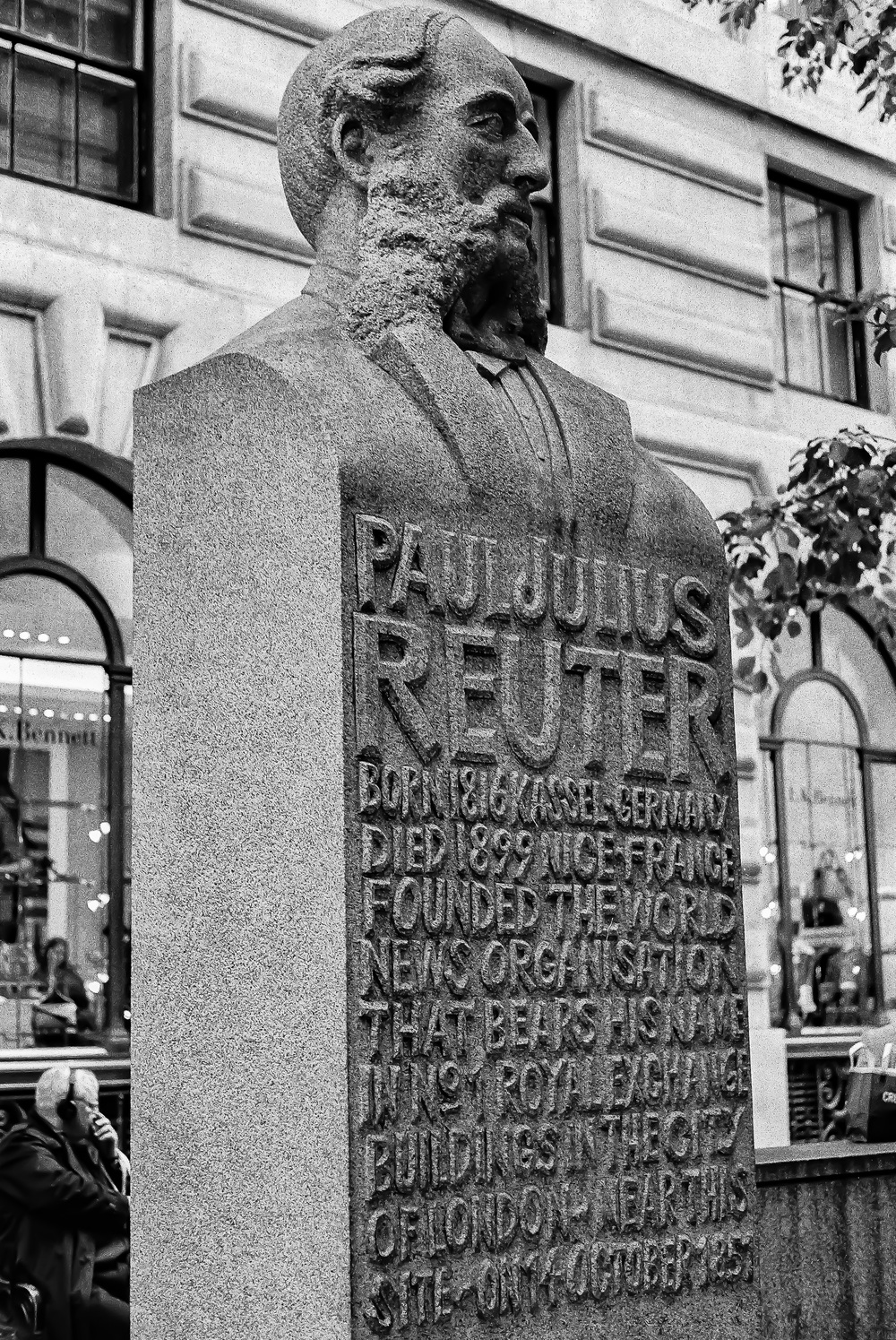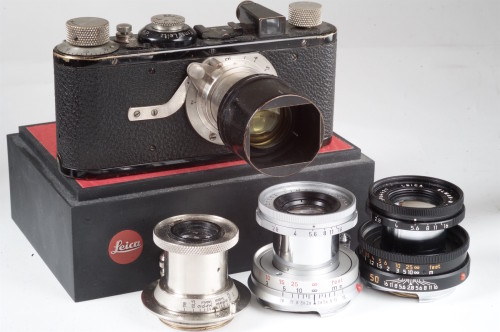
The 50mm Elmar lens dates back to 1926 when it replaced the original Anastigmat and Elmax lenses of 1925 on the LEICA 1 (Model A). The Elmar 50/f3.5 was collapsible and was fixed to the body. The lens was locked at infinity by a large spring on the body nicknamed the “Hockey stick”. This fixed lens was produced from 1926 to 1930 and took slip-on filters and a slip-on lens hood with a unique rectangular mask built into the front edge.
Carl Merkin has produced an interesting history of Leica’s classic standard fifty, the Elmar, from the original f/3.5 designs through to the late f/2.8 which was introduced in 1994 as part of the jubilee celebrations to mark forty years of M photography. Find it here on the Leica Camera Blog

I own two versions of the Elmar, both f/2.8. The first is a silver 1965 lens which came with the M2-with-provenance that I acquired earlier in the year. The second, which came from the extensive collection of second-hand Leica lenses available at Red Dot Cameras in London, is the later model manufactured in 1996.
Competent, sharp
Although rather overshadowed in popular lore by the Summicrons and Summiluxes, this Elmar is a thoroughly competent and sharp lens which has the advantage of being ultra compact. Retracted, it protrudes barely 2cm from the lens mount and converts any M into an almost pocketable camera. I am not brave enough to collapse it on a digital M for fear of hitting the sensor, although I have been told that it is possible with care. Attempt this at your own risk; personally I prefer to leave it extended on the M or Monochrom.
But on a film camera, such as the M4-P used in the cover photo above, the Elmar makes a delightful combination. My colleague Bill Palmer is a great fan of this lens and some months ago we had a discussion about the somewhat fiddly nature of pulling out the lens and twisting to lock. He advised me to persevere and now it comes as second nature. In comparison with the more popular and faster f/2 and f/1.4 lenses (or even the f/2.8 Elmarit), the f/2.8 Elmar is a relative bargain and can be picked up, in good condition, for upwards of £500. It makes an ideal starter lens for an M system, particularly if you are a nifty fifty type of person. It’s just the job for street photography.
For a full rundown on the late Elmar-M, have a look at the industrious and fulsome Mr. Rockwell’s page.
The cover photograph was taken on my M4-P with the late-model f/2.8 Elmar. This combination turns the M into a pocketable camera, even more so than when using the modern and current f/2.8 Elmarit. All you need is a wrist strap and you are ready for some serious street work.
If you enjoyed reading this article you will like William Fagan’s excellent advice on collecting vintage Leicas

Hi Mike – I just dug this out of your archive and having just picked one up at Red Dot I am back in love with it (yes I foolishly sold one about five years ago). In fact when I was talking to Ivor on Thursday he picked up the phone and it was you calling. You were due over in a few minutes but I had to belt off to anther appointment. I have just had a lens cull and decided 50mm was the only place I wanted to double up: a fast one, a Nokton 1.2 V2. and this 2.8. One for low light and wide open and the other, this one, for portability and general use and it is a cracker. Don’t be afraid to collapse it I have it on my M10-P and discussed the matter with Jimmy Hughes who I guess you will know for tech support at Mayfair. He assured me there would be no problem, and there isn’t. So one less worry. I enjoy your musings as ever. All the best. Des
Thanks, Des. It would have been good to meet. But I didn’t get there until after 1pm as far as I can remember. The 50 Elmar is a cracking little lens. I also have a tendency towards 50mm, although the Q opened my eyes to the wider options.
Mike
Dear Mike
If you are checking with with Leica, you need to ask about different variants, including the LTM models. My research indicates that there can be variations in lens barrel length.
William
As far as I know the comments applied only to the latest 1996 version. I also remember someone saying that it was advisable to extend the lens before mounting. Again, I need to check and in the meantime I would advise any readers NOT to attempt collapsing the Elmar on a digital M.
I also own a fine example of the late Elmar, in silver, and it is one of my favourite Fifties. I love it on the M9 but, like you, I am afraid to collapse it in case of sensor damage.
You aren’t the famous "Ronnie" Haskins, scourge of Jack Regan of the Sweeney are you?
Dear Mike
The photo is lovely. Don’t mind those ‘pixel peepers’ who look for ‘noise’ in every photo.
The 5cm/50 mm f3.5 Elmar is the lens that made Leica and, without it’s success, we would have no M9s, M240s or M262s to play around with. Over 360,000 copies of the original f3.5 lens were sold between 1925 and 1959. Van Hasbroeck lists 22 variants of the lens, including the 2.8 variant which you have. I have been doing some research on the early models and there may, indeed, be even more variants which came with the very early 1 Model A. Not boasting, but I have 16 5cm/50m Elmars, covering at least 7 of the Van Hasbroeck variants and, as I said, there may be more variants to be identified in this lot when I have finished my research. One reason why I have so many Elmars, is because I collect early screwmount (LTM) Leicas and most of them come with an Elmar fitted, almost like a ‘bottle top’ or ‘body cap’.
The lens is, of course, much better than that and, if you can get a good copy, it will produce superb images. Indeed, the original f3.5 LTM model is, when stopped down in a good copy, on a par with many modern lenses. It will also give you a vintage look, particularly if you have an uncoated version. It is the one lens that all Leica users should try, at least once. It will give superb quality in a compact package. Be careful, though, about collapsing it when using it, via an adaptor, on a digital body.
Using the Elmar may give the Leica photographer a taste for other vintage Leica lenses, such as the Summar. A good copy of that lens can, when shot wide open, give the Leica photographer truly spectacular results not obtainable with modern lenses. It’s all about ‘character’, if a lens can be said to produce this.
William
William, very useful additional information. I ought to have linked to your earlier article on your collection and I will do so. On collapsing protocol, I believe the latest version of the f/2.8 can be collapsed on a digital body but I am not going to recommend it. I will check again with Leica and, if they give me chapter and verse will add it to the story (without responsibility on my part!).
Yes Mike it is a great lens, that page is still open on my Safari, along with another…
http://www.35mmc.com/10/12/2015/finding-photo-mojo-forty-rolls-tri-x/?etmonarchpopup=true
I have been getting completely distracted by what Leica might do next, when there is so much to learn from what they have already done.
Inspired by the chap in Saigon (see above) and that piece on the Elmar, I feel inspired to go out tomorrow, and shoot with the ancient M2/50 that I already have, and stop worrying about SL’s, T’s, X’s, M’s and all the other what might be’s!
At least until the January sales suck me in again anyway!
Go for it and let us know how you get on!
I went for it Mike…
Too much grain!
So much that the results no longer look like photographs, much more like spent 1950’s fish and chip paper.
Back to Tri-X @ 400 for me sir.
I might even be tempted to look for a nice used Leica Monochrom, I prefer that output by miles!
You’ll have to expand on your experience here, I’m a bit lost. What did you go for in the end?
The Monochrom is an excellent camera, either the original M9-based version with the CCD sensor or the new CMOS version. They’re holding their second-hand values quite well, though, so not many bargains to be had.
I went out and shot a roll of Tri-X 400, pushed to 1600… Developed it in Rodinal R09.
Subject matter was Lesnes Abbey, in Abbey Wood, which is very close to where Kubrick’s "Clockwork Orange" was filmed…
…So mostly ancient stones and gloomy skies, but one shot featuring an element of 1960’s concrete.
Not so sure about some of my compositions, but the grain is so heavy, that it becomes a caricature of photography…
…See the article I mentioned above, with the chap who has taken some shots of Tokyo…. 40 rolls!
I am merely suggesting that whatever the Leica lens we choose, they don’t deserve to be effectively undermined almost to abstraction… Better to start with a top notch image, and corrupt it in Photoshop/Iridium/Lightroom/SilverEffex (whatever) during development if required.
I understand and tend to agree with you. Eric Kim, for instance, is a great proponent of pushing Tri-X to 1600 but I haven’t tried it for myself. I’m still experimenting again with film after forgetting all my previous-life experiences following the advent of digital.